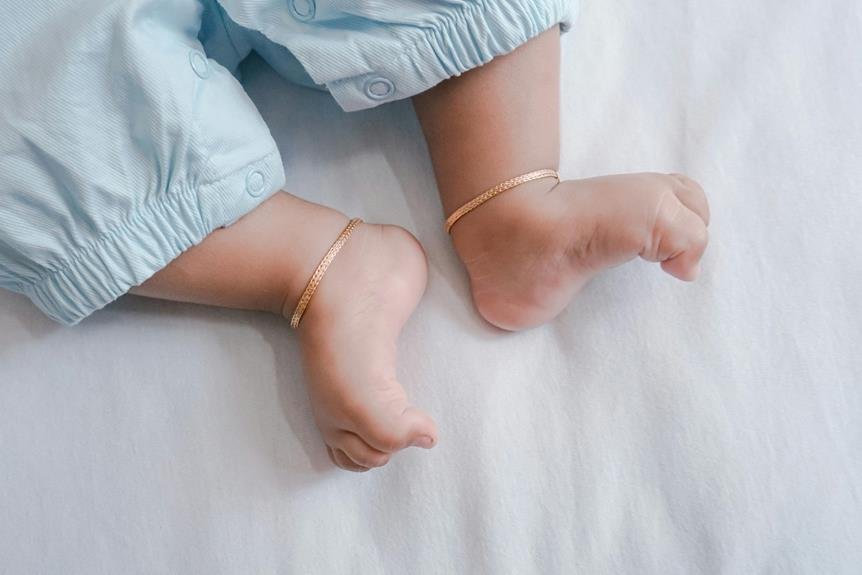If you're a parent dealing with common baby skin issues like diaper rash and eczema, knowing how to address them effectively is crucial. The key lies in simple yet essential steps that can make a significant difference in your baby's comfort and well-being. By understanding the root causes and implementing gentle yet targeted remedies, you can navigate these skin concerns with confidence. Remember, a few proactive measures can go a long way in ensuring your little one's skin stays healthy and happy.
Understanding Diaper Rash
If your baby develops a diaper rash, you can soothe their discomfort by following these simple steps. Firstly, it's crucial to keep the diaper area clean and dry. Change your baby's diaper frequently, and gently clean the area with a mild baby wipe or warm water. Allow the skin to air dry before putting on a fresh diaper. Avoid using harsh soaps or wipes that may irritate the skin further.
Next, consider using a diaper rash cream or ointment to create a protective barrier between your baby's skin and the wetness of the diaper. Look for products containing zinc oxide or petroleum jelly, as these can help soothe the irritated skin and promote healing. Applying the cream thinly and evenly during diaper changes can prevent further irritation.
Furthermore, opt for loose-fitting diapers to allow for better air circulation and reduce friction on the irritated skin. Avoid tight diapers or clothing that can worsen the rash. Lastly, if the rash persists or worsens, consult your pediatrician for further guidance and treatment options. By following these steps, you can effectively manage and alleviate your baby's diaper rash.
Treating Diaper Rash Effectively
To effectively treat diaper rash, keep the diaper area clean and dry, change the diaper frequently, and use a protective cream containing zinc oxide or petroleum jelly. When changing your baby's diaper, gently clean the area with mild wipes or warm water and pat it dry before putting on a fresh diaper.
Allowing the skin to air dry for a few moments can also be beneficial. Applying a thick layer of diaper cream that contains zinc oxide can act as a barrier between the skin and moisture, helping to soothe and protect the irritated skin. Petroleum jelly can also provide a protective barrier and help with the healing process.
Remember to use fragrance-free and hypoallergenic products to prevent further irritation. If the diaper rash persists or worsens despite these measures, consult your pediatrician for further evaluation and treatment options. By following these simple steps, you can effectively manage and treat diaper rash in your baby.
Identifying Eczema in Babies
When caring for your baby's skin, it's important to be able to recognize the signs of eczema early on. Eczema in babies often appears as red, dry, itchy patches on the skin. These patches may be rough or scaly and can occur on the face, scalp, arms, legs, or other parts of the body. Babies with eczema may also experience skin that's inflamed, sensitive, or oozing clear fluid. It's essential to pay attention to any changes in your baby's skin and consult a healthcare provider if you suspect eczema.
Moreover, eczema can cause discomfort for your baby, leading to increased fussiness or irritability. If you notice your baby scratching or rubbing their skin frequently, it could be a sign of eczema. Additionally, eczema may worsen with exposure to certain triggers like irritants, allergens, or changes in temperature. By being vigilant and recognizing the early signs of eczema, you can take proactive steps to manage and alleviate your baby's discomfort.
Managing Eczema Symptoms
Upon noticing eczema symptoms in your baby, implementing a gentle skincare routine can help manage discomfort effectively. Opt for mild, fragrance-free cleansers during baths to avoid further irritation. After bathing, gently pat your baby's skin dry and apply a thick, hypoallergenic moisturizer to lock in moisture. Keep your baby's nails short to prevent scratching, which can worsen eczema flare-ups.
Clothing choice plays a significant role in managing eczema symptoms. Dress your baby in soft, breathable fabrics like cotton to reduce skin irritation. Avoid wool and synthetic materials that may aggravate eczema-prone skin. Additionally, washing your baby's clothes with a gentle, hypoallergenic detergent can help prevent further skin irritation.
If your baby's eczema persists or worsens, consult with a pediatrician or dermatologist. They can provide personalized treatment recommendations, such as prescription creams or ointments, to help manage severe eczema symptoms. By following these skincare practices and seeking medical advice when needed, you can effectively manage your baby's eczema and promote healthy skin.

